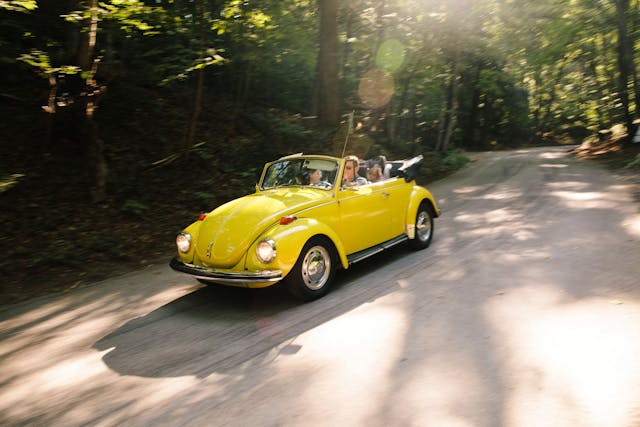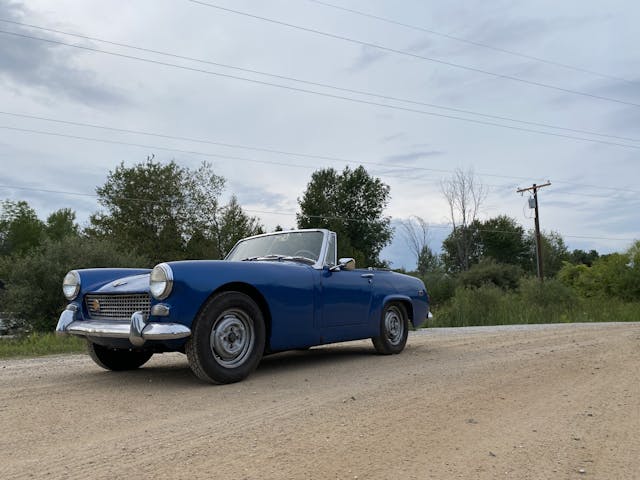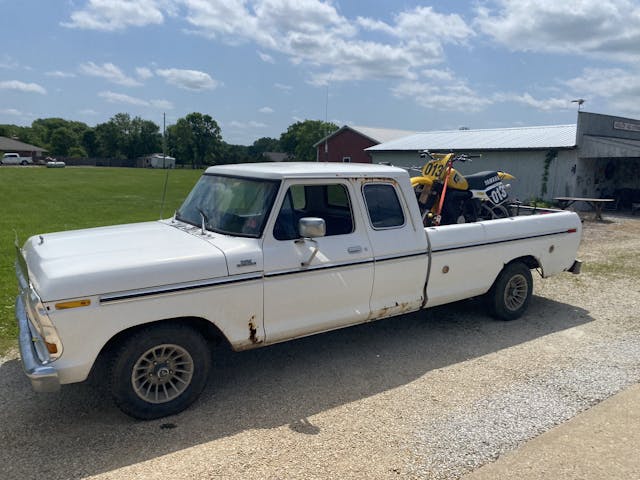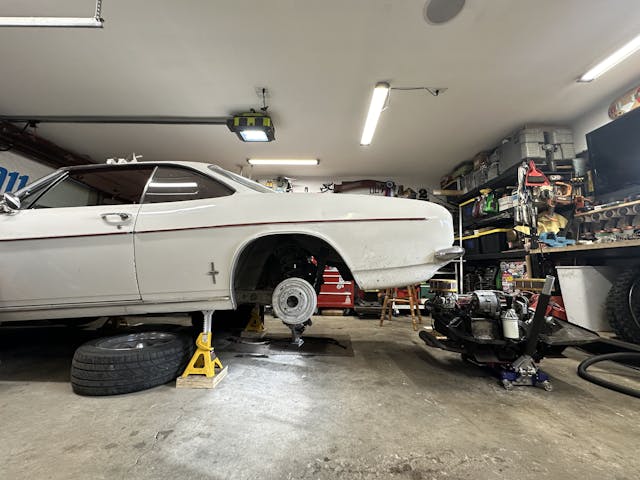Media | Articles
5 Fantastic First Project Cars
When it comes to a project car, it’s best to dive into one that truly lights a flame inside you. A project car is almost always mentally, physically, and financially draining at some point in your relationship with it. If you don’t care to stick it out through such hurdles, frustration might block you from ever returning to the project again.
So, where to begin? The list of needy cars for sale from the world’s garages, carports, driveways, and open fields can seem overwhelming. It can be easy to dream big. Of course, hell-on-wheels traps exist; certain cars are difficult to source parts for, offer minimal community and owner support, or are just plain prone to breaking.
Some cars, on the flip side, offer a stronger foundation for novices. Today we’ll be donning the role of Car Matchmaker. Whether you’re new to the hobby or a veteran, smoother-sailing and joy-to-own DIY classics are out there— here are five vehicles we think might be right for you:
Little British Cars
A cheap British sports car can offer plenty of, uh, opportunities to bond with the mechanically inclined owner. The nice thing is that there were tens of millions of Austin-Healeys, Triumphs, and MGs produced during the 1960s and ’70s that share much in terms of maintenance parts and techniques. The cars are relatively affordable, and thus, so are the parts. The biggest boon: support and knowledge provided by other enthusiasts. British car clubs are often large and helpful—perfect for a newbie to the genre.
Volkswagen Beetle

The Beetle dethroned the Model T for the outright model sales record, eventually going on to account for over 21 million sales. There is safety in numbers, which often correlates with good parts support and pricing. The aftermarket support for Bugs is downright impressive, even compared with other mainstream vintage cars like Mustangs or Chevelles. Beetle owners will get familiar with regular maintenance like oil changes and valve adjustments, but the fundamental build and design are sturdy; if you do the job right the first time, you likely won’t have to do it again unexpectedly.
Marketplace
Buy and sell classics with confidence
Ford Model A or T
You want to learn the basics? Then buy one of the most basic cars you can drive. Just stare at a Model T for more than a few minutes, and you’ll notice that none of the critical parts are hiding. Everything is pretty out in the open. Best of all, components were overbuilt by a factor or two in most areas. Model Ts—and As, for that matter—don’t require many power tools, which means they’re accessible and enjoyable to work on whether you’re a tool rookie or an experienced wrench. Fun to learn on and fun to drive? That’s a good project car.
Trucks of the 1970s and ’80
As simple as the aforementioned Fords are, their age comes with real-world usage limitations. If a utility is an aspect you value in a finished project car, vintage pickups from the 1970s and ’80s are a great place to look. These are rugged, tough hunks of metal that enjoy fairly high tolerance for deferred maintenance. If you are willing to buck up and take on the challenge of catching up on all the stuff the last owner neglected, the juice can be worth the squeeze. Fruits of your labor will include functional overdrive transmissions, disc brakes, and decent power, all baked into solid packages with relatively simple powertrains and chassis. Being trucks, they also have beds for work—or pleasure hauling. For those without a utility-focused daily driver, that’s a nice bonus when trying to justify how a collector car fits into your lifestyle.
Anything you don’t expect to daily drive
In reality, just about anything that makes you look forward to dirty hands and busted knuckles is the right project car. Expectations, however, are important; old, semi-working cars tend to behave like old, semi-working cars—they can break down and sit out of commission for extended periods. Take it from me: Spending Sunday evening underneath your car is a lot more relaxing when you don’t need the thing to get to work the next morning.
*
The whole project car process, even if it requires a long timeline, can be as rewarding as the end result. The thrill of parts finding is sometimes more thrilling than installing or even using said parts; whether buying something that requires lots of networking and parts hunting might be perfect for you, as long as you go down that road with both eyes open. Tougher endeavors in that vein hone project-car skills, but the learning curve is often steep and time-consuming. Patience is essential, so if you want more immediate gratification, relative oddball stuff like Wankel-powered NSUs or Nash Metropolitans may not be the ideal place to get your feet wet.
Find a car you think you’ll love, and the learning, fixing, and driving it all become part of the adventure. Get some experiencce under your belt and before you know it, you’ll have more than one project in the pipeline—don’t say we didn’t warn you!
***
Check out the Hagerty Media homepage so you don’t miss a single story, or better yet, bookmark it. To get our best stories delivered right to your inbox, subscribe to our newsletters.










There are many decent, simple and affordable options. I have a 78 AMC Concord D/L that I bought about 5 years ago for a very good price. Car has been running and driven daily around 5 months per year. I call it a “Rolling Restoration”. Driving helps find issues, keeps systems working and helps you decide what direction to take next.
It is hard to imagine vehicles of the past 15 or 20 years becoming classics with the multitude of plastic components and so many computers controlling tail lights to the engine. Maybe some third party might step up but I doubt it.
I have a 1972 yellow convertible SuperBeetle in great (body and top) condition; original German engine needs rebuild or replace. Want to sell as is or have engine repaired or replaced.Photos upon request. In Chicagoland
Before you tackle a project car do an extensive search on parts availability and cost, freight cost which sometimes is more than the cost of the part. Evaluate your skill level. Do you have the necessary tools. Don’t get something that you’ll need others to fix. Look for forums that involve your type of vehicle so that you can ask others if you have a repair issue your not sure of. My suggestion about project cars is don’t do it. Buy a car that is in good running order that you can use daily. Then you can put your own personal touches to it. This coming from a 15 year and counting “project” car restorer money pit. More fun to wash and wax and drive that car then sitting on blocks. Just my opinion.
Anyone interested in a Lite Pewter Corvette Convertible? Manual 6 speed, black interior and top, 43K miles, garage queen, $22,500. No apologies car, Middleburg Florida
It’s a 2002 Base model C-5 Corvette. Sorry
Of “Corsa” I agree, since I’m in the midst of restoring a ’66 Corvair Corsa 140 horsepower coupe (insured with Hagerty, of course). All of my old non-metric tools fit, as does my life-long Chevrolet/Cadillac hobby focus. These cars are still comparatively inexpensive, and parts support and availability are great.
Love the Little British Cars. And you get your garage floor oiled for free!
Keeps the rust worms out of the undercarriage.
re: Metropolitans may not be the ideal place to get your feet wet.
I OK with the 5 cars that Kyle listed, but have to disagree with his comment about the Mets. I bought my first old car, a Met, 48 years ago and have been fixing cars since then. It was a perfect car to start with then and it still is today. Its just another little British car. There is a great source of parts, there is an active club that is eager to provide technical support and there are few cars that will get the smiles that a Met will. Its small enough you can get your arms around it and you can do one in a two car garage and have room for your daily driver. You can take a finished car or a beater to any cruise in or meet, and Mets are welcome at Hudson, Nash, most British meets and of course the big Metropolitan meet every couple of years. The 5 cars you listed are OK, but I can not think of a better car to start with than a Met. Bill
Nice list, Kyle. And I’ve had, over the years as daily drivers, and wouldn’t hesitate to re-acquire any of them. With the exception if the Healy Sprite. As a first project, the Healy could present a host of restoration issues no in the realm of a first-timer. Notably rust. Old Sprites and Beetles were known for rust, especially with the chassis, and proper resolution requires a whole set of skills that take years to perfect. Unlike many areas where it isn’t an issue, a lot of us are in real winter conditions that make heavy use of salt on the roads. It’s really not a pretty picture.
No mention yet of Alfa Romeo Spiders? I’m on my fifth Spider since my 20s. They’re still attainable, quite reliable (seriously!), and not hard to repair. Sure, the stereotypical “Italian Sports Car” is expected to be expensive and temperamental. But because so many were made from the sixties to the 90s (my current one is a ’93), parts were shared over many years and there’s a robust range of suppliers and a helpful community.
I’ve owned many, many great cars, but the Spiders still make me smile!
My experience is with a 78 Spitfire. When I got my car parts were dirt cheap, still not too bad. The 4 banger is simple, easy to work on, pretty much everything can be done in the driveway with a single person. Lots of support and parts are easy to get. If you want to teach someone how cars used to work, this is a pretty straight forward example. What I might like best is the heater. Not that is all that great but a couple of levers that open a valve or move a shutter to send the heat where you want. No vacuum lines, no electronics, simple; the way every heater still ought to be
I have two current projects; a 1974 Nova SS and a 1997 camaro SS. The Nova was a major rust bucket, and the camaro had been garaged its whole life. I bought the Nova because it had never been hit or bumped, had its original paint, and it was an original, floor-shifted, manual trans car. Because it had never been hit, I knew that the internal body parts and structure would not interrupt body panel fitment.
The camaro was in excellent condition (other than a blown engine), but it was a PAIN trying to get it to run! I had to test so many wires, modules, relays, replace defective electronic parts, etc., that I lost a lot of love for that car.
In this case, the basket-case Nova is the more pleasurable project, due to its simplicity.
Alfas are great, My brother in Palm Desert has a 1972 Spider, for sale $444.00, no title, no engine, cooking out in the sun with top down for 7 years, good body parts. I am trying to help him get rid of some of his abandoned cars. Bill 952-210-1242
I have been restoring Porche 356s for decades. I’ve switched to British for fun and a change. Just finished a 1948 Crosley/Devin/MG. Just got a 1974 TVR out of paint. A TR-6 drive train. MY 69 Berkeley is my “Lady” in waiting. ………Jim.
Well back in the day when you could by a
old shoebox Chevy or ford, for a 100.00 bucks you would be able to go from one end to the other. They were pretty self explanatory. I agree that the newer rides have to much to do with electronics. Unless you have a good friend in the mechanic business, it can get a little crazy figuring out those bugs. But that’s the evolution of todays rides. Good education for the back yard mechanic though. It seems like as mentioned a 70s ride would probably be what the doctor ordered. Lots of plastic but at least you can get your hands dirty and not screw up to much on them.